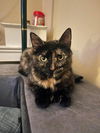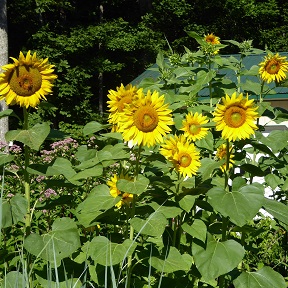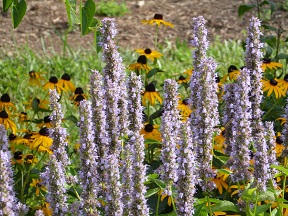FLR Backyard Habitat
by Peggy Schochet
Quick Links
FLR Goal - Let's Make a Difference
At FLR, we have a Fierce Love and dedication to all wildlife -- birds, butterflies, amphibians, reptiles, and mammals. We are committed to rescuing animals in need, and to educating people of all ages about doing what they can do to save nature’s treasures. In today’s world of so much development, habitats are needed more than ever. We believe that if we all put our Fierce Love and dedication into restoring natural habitats, together we can and will make a difference.
Why Create a Backyard Habitat?
Creating your backyard habitat will take you into another world right in your own garden. It is a world filled with beauty and wonder that has existed undetected right in front of you. Your garden will be alive with insects, birds, frogs, lizards, and other species.
A backyard habitat area.
If we truly want to help wildlife, we need to change our way of thinking. Our native insects, wildlife and plants have co-existed for thousands of years to form an important food web. Our insects depend on native plants for food, and mammals and birds depend on the insects and native plants for food. Our plants depend on birds and mammals to spread their seeds, and our butterflies and bees to pollinate their flowers. Non-native plants do not supply the nutrients that that our wildlife needs. Also, many insects are specialists and only eat or raise their young on a handful of native plants. Non-native plants do not necessarily bloom at just the right time when certain pollinators need it - this synchronized timing took thousands of years to happen.
Consider the Chickadee
Doug Tallamy, a Professor in the Department of Entomology and Wildlife Ecology at the University of Delaware, conducts research to better understand how insects interact with plants, and how those interactions impact the diversity of wildlife. His numerous books and papers include
Bringing Nature Home and co-authoring
The Living Landscape with Rick Darke.
Professor Tallamy teaches the amazing lesson of the Chickadee:
Like most baby birds, Chickadee nestlings need digestible food that is rich in protein and nutrients and caterpillars fit the bill. Professor Tallamy studied a Chickadee family over a period of about 18 days until the baby birds fledged. Amazingly, the Chickadee parents delivered their babies about one caterpillar every three minutes which equaled up to 350 to 570 caterpillars a day. Over 18 days it took 6000 to 9000 caterpillars for one Chickadee family to raise their fledglings.
Only native plants are hosts to our caterpillars. You will rarely find caterpillars on non-native trees such as Bradford Pears and Crepe Myrtle. Although these trees are beautiful, they do not help support our wildlife in the U.S. Professor Tallamy explains that trees native to the U.S. support many species of caterpillars as shown in the table below. Looking at the numbers in the table, we can see that these four trees produce some "serious" food for baby birds.
| Tree | Caterpillar Species Supported |
|---|
| Native Oak |
534 |
| Tulip Poplars |
367 |
| Native non-fruiting Cherry trees |
457 |
| Willows |
455 |

What Are the Advantages for Us?
Beauty:
- Habitat gardens are beautiful.
- Habitat gardens create a sense of place, perhaps one with which we are not overly familiar.
Maintenance:
- Habitat gardens require less weeding - plantings are closer together to provide cover for the wildlife.
- Native plants require minimal watering (except when they are being established and during droughts).
- Native plants do not need chemical fertilizers or pesticides.
Protecting Our Ecosystem:
- Native plants provide food and shelter for our local wildlife.
- Native plants have their own, (already) established place in our local ecosystems.
- Natural habitat gardens counteract the effects of development, turf grass, and non-native plantings.
The world of nature needs our help and we at FLR believe it is our responsibility to do just that. We want to help you create a backyard habitat (small or large) where nature does not just survive but thrives. In today’s world of increased development coupled with beautiful, green lawns (which do not support the "good guy" species), habitats are needed more than ever.

How to Create Your Own Habitat
There are some simple steps you can take to begin creating a habitat area in your backyard. You can start small with just one or two steps - each step you take makes a difference for the species that share our space.
WATER - Put In a Bird Bath, Fountain or Puddling Area
- Consider putting in a bird bath or fountain in your habitat.
- Add a small heater so the birds will have water all winter long.
- Make a puddling area for butterflies and other insects.
- Fill a shallow tray or saucer with some sand or coarse dirt and a few pebbles. You will need to keep the puddling area moist.
- You can also add some salt, compost or manure for added nutrients.
SHELTER - Keep Brush Piles, Rock Piles, and Tree Snags
- Keep a brush pile in the corner of your yard all winter long to offer shelter from the elements.
- Wait to cut down ornamental grasses until the spring - they serve as protection from the winter weather for many birds and other wildlife.
- Add rock piles - they are vital shelter for toads, salamanders and lizards.
- Leave tree snags in areas where they are not a danger to humans or structures - they offer shelter for birds and other mammals. Some 85 species of birds here in America make their homes in dead trees.
FOOD SOURCES - Incorporate Plants in Your Yard & Habitat
- See the "What Plants Should I Use" section below where we list different types of plants that might work in your yard.
NESTING AREAS - Leave Hollow Sticks, Put Up Birdhouses and Nesting Boxes
- Leave hollow 12" sticks from plants such as Joe Pye Weed on the floor of your garden for female native bees.
- The females will lay eggs in the hollow sticks.
- They will stash a bit of pollen for each egg so when the eggs hatch they will have some sustenance to start their life cycle.
- Put up birdhouses and nesting boxes.
- Spread the houses out so they are not too close to each other.
- Make sure the houses are not facing each other.
- If you want to ensure that sparrows don't take them all, you will need to install at least six birdhouses.
- Bluebird houses need to be deeper than the average birdhouse because Bluebird nestlings are very curious baby birds and love to stick their heads out of their house to see what is going on well before they are ready to fly. The house needs to be deep so they don't fall out.
- Bluebird parents like to perch nearby and see the opening of their house to watch their nestlings so place the bluebird houses six to eight feet adjacent to a shrub or fence.
Of course with a natural habitat area, you never really know which species might take a walk through your birdhouse.
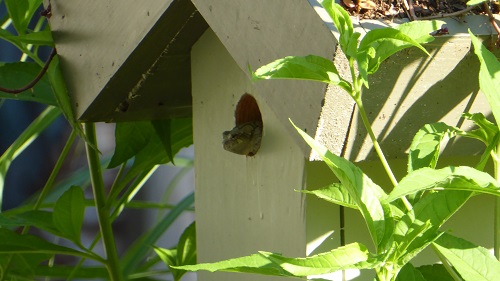 Tree Frog in a birdhouse.
Tree Frog in a birdhouse. 
What Plants Should I Use?
The decision of which plants to use can be a personal one. You may have preferences for size, texture, and color. You may want to attract certain wildlife species to your yard. Careful planning can create an oasis in your yard - one that is not only beautiful but provides sustenance for the species that inhabit the outdoors.
The plants you use for food and cover will help determine the wildlife that is attracted to your backyard. In the tables below, we suggest certain varieties of trees, shrubs, vines, flowers, and grasses, and give you an idea of the most important benefits of each plant. For further guidance on what to plant, we suggest that you visit the National Wildlife Federation's plant finder page (
https://www.nwf.org/NativePlantFinder).
TREES
When you consider planting trees, think about trees that support the most caterpillars, have berries and nuts for the wildlife, and provide shelter. The Oak tree is a clear #1 choice for species support.
| Tree | How It Helps |
|---|
| Oak |
Not only does the oak support the most species of caterpillars, it feeds deer, squirrels, chipmunks, wild turkeys, rabbits, opossums, quail, raccoons and many more. |
| Tulip Poplars |
The Tulip Poplar is the host plant for the Eastern Tiger Swallowtail. Its nectar is a favorite of hummingbirds and Cedar Waxwings. |
| Maples |
The Maple offers seeds for food, and hosts almost 300 butterfly and moth species. |
| American Beech |
Beechnuts are a vital food source for all wildlife. |
| Willows |
The Willow is one of the first trees to flower and provide nectar in early spring. |
| Native non-fruiting Cherry trees |
Birds, fox, chipmunks, raccoons, and mice eat the fruit. The tree is a a host plant for the Red-Spotted Purple and the Tiger Swallowtail butterflies. |
| Serviceberry |
The Serviceberry is a perfect substitute for a Crepe Myrtle. It is also host to the Red Spotted Purple butterfly. |
| Flowering Dogwood |
Flowering Dogwoods are an excellent energy source for migrating birds. |
| Cedars |
Cedars help many birds survive the winter by offering an abundant supply of food and winter shelter. |
| Pines |
Pines are ranked high among other conifers for their value to birds. Pine seeds are eaten by at least 48 species of birds. Needles are used as nesting materials. Pines also offer nesting sites and shelter. |
| Hackberry |
The Hackberry is a host to several butterflies including the early bird Mourning Cloak. |
| Holly |
Birds, squirrels, raccoons, skunks and deer enjoy the berries. |
SHRUBS
Shrubs can add visual interest to your garden. When choosing shrubs, you might consider a combination that provides food and shelter for each season.
| Shrub | How It Helps |
|---|
| Spicebush |
The Spicebush is a powerhouse shrub for wildlife with flowers that come early in the season for the early emerging bees. |
| Summersweet or Sweet Pepperbush |
These are a magnet for butterflies and a hummingbird favorite for its nectar. Its seed is a food source for birds. |
| Viburnum (Dentatum) and Elderberry |
These have lots of berries for the birds and mammals. |
| Winterberry |
Its berries are a favorite of many birds and rabbits. |
| Buttonbush |
The Buttonbush is a butterfly magnet that offers up berries in the fall and winter. |
| Chokeberry |
Chokeberry is another abundant source for fall and winter berries. |
| Azalea, Mountain Laurel and Rhododendron |
These shrubs are an important nectar source for early spring emerging bees and butterflies. |
VINES
Planting native vines offers nectar for bees, butterflies, and other pollinators, as well as fruits, berries, and seeds for birds and many other small mammals.
| Vine | How It Helps | |
|---|
| Passion Flower |
The Passion Flower is easy to grow with a beautiful yet unusual flower and it is the host for several Fritillary butterflies. |

Pipevine Swallowtail eggs on Dutchman's Pipe vine.
|
| Hops |
Yes, hops is used to make beer but it is also the host plant for the Question Mark, Comma, and Red Admiral butterflies. |
| Dutchmans Pipe |
The Dutchmans Pipe is a host plant for the stunning Pipevine Swallowtail. |
FLOWERS
Native wildflowers can be used in a formal garden setting by selecting plants that have a neat and tidy appearance such as Purple Coneflowers, Black-eyed Susans, Bee Balm, Liatris, Tickseed, Wild Blue Indigo, Perennial Sunflowers, Garden Phlox, and Anise Hyssop. Native flowers are vital sources of nectar and pollen for butterflies, bees, and other insects. They also provide nectar and seeds for birds, and fruits and seeds for other animals.
Mix in some annual flowers that are not necessarily native, but will bring butterflies and other pollinators into your habitat. Some favorites are Sunflowers, Mexican Sunflower (a favorite of the Monarch butterly), Zinnia, Cosmos, Lantana, Petunias, Impatiens, and Salvia.
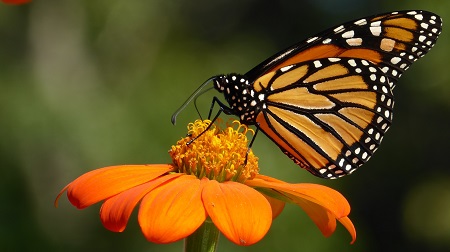 Monarch butterfly on a Mexican Sunflower.
Monarch butterfly on a Mexican Sunflower.In particular, sunflowers are a wildlife power food. They provide:
- Pollen for the bees
- Nectar for the butterflies and hummingbirds
- Seeds for the birds, squirrels and other mammals
- And a comfortable bed for the bees to spend the night
Native, dual-purpose flowers provide nectar and pollen for insects and butterflies, and seeds for the birds.
| Native, Dual-Purpose Flower | |
|---|
| Purple Coneflower |

Purple Coneflower.

Bee Covered in Pollen on Hibiscus.

Bee Balm with Bumblebee.
|
| Joe Pye Weed |
| Goldenrods |
| Anise Hyssop |
| Yellow Giant Hyssop |
| Purple Giant Hyssop |
| Asters |
| Black-eyed Susans |
| Cutleaf Coneflower |
| Cup Plant |
| Hibiscus |
| Sedum |
| Garden Phlox |
| Bee Balm |
| Liatris |
| Culver's Root |
| Perennial Sunflowers |
| Blue Wild Indigo |
| Tickseed |
| Hummingbird Flower | |
|---|
| Cardinal Flower |
|
| Great Blue Lobelia |
| Native Honeysuckle |
| Bee Balm |
| Salvia |
| Anise Hyssop |
| Yellow Giant Hyssop |
| Purple Giant Hyssop |
The most beneficial Milkweed to grow in the mid-Atlantic region for the Monarch butterflies are Common Milkweed and Swamp Milkweed. Please note that
Milkweed plants are poisonous. They contain a toxin that can be harmful to people, pets, horses, and livestock. To be safe,
do not plant milkweed where children and pets play or animals graze.
| Milkweed | About Milkweed |
|---|
| Common Milkweed |
Common milkweed is better suited to a garden setting. |
| Swamp Milkweed |
Swamp milkweed spreads by underground rhizomes and is best used to form a colony. It is a good choice for a poorly drained area. |
GRASSES
Native grasses are especially important for your habitat. They are considered one of nature's "workhorses." They provide food (seeds), nesting places, nesting materials, and cover for protection. Native grasses are so important for native insects, as they rarely eat non-native plants. And insects (such as the Praying Mantis) overwinter on grasses.
Native grasses can be more visually pleasing when planted in masses. You can group them in your butterfly garden; use them as a border for your lawn, walkways, patio or driveway.
| Native Grass | |
|---|
| Big Bluestem |
|
| Little Bluestem |
| Muhly Grass |
| Indian Grass |
| Switchgrass |
| Pennsylvania Sedge |
| Gray's Sedge |
| Northern Sea Oats |

Helpful Hints
- Plant your shrubs and flowers at different heights in your gardens - this approach offers areas for birds to perch and areas for them to quickly hide if needed.
- Plant a row of shrubs such as native Azaleas and create a sheltered highway for the birds and small mammals to get from one place to another under cover from predators above.
- Tolerate a bit of messiness in your habitat area over the winter months - do your fall garden clean up in the spring. Leaving plants in place for the winter:
- Provides wildlife with seeds and berries for food all winter long.
- Protects any beneficial insects and butterflies over-wintering on your plants.
- Provides shelter in the winter months.
- Dried plants are much easier to clean up in the spring.
- In the fall, rake some leaves into your gardens instead of out.
- This will give insects and butterflies a place to spend the winter.
- And, it will give birds a place (such as the Juncos and Carolina Wrens) to hunt for food.
- Add hollies that have berries all winter long and offer dense prickly protection from predators.
- Consider investing in outside, motion-detector lights. When exterior lights are left on all night long, moths spend the entire night attracted to the light instead of mating.
- Eliminate pesticides, herbicides, and synthetic fertilizers. Instead, consider using natural fertilizers.

How Do I Know If I'm Doing It Right?
Frogs, toads, lizards, skinks are indicator species. This means if you have an unhealthy environment, sadly they will be the first to go. If you have an overabundance of these species, you have successfully created an FLR Backyard Habitat.

Peggy Schochet - Peggy is a Master Gardener who specializes in habitat gardening. She graduated from the Old Rag Chapter of Master Naturalists and is currently studying herbalism at Forrest Green Farm in Louisa, VA.











